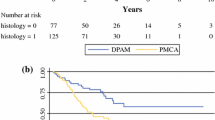Abstract
Background
Even though management of pseudomyxoma peritonei (PMP) was improved with cytoreductive surgery (CRS) and hyperthermic chemotherapy (HIPEC), several aspects of PMP still need to be optimized, including patient selection for surgery and prognostic factors. We assessed the role of preoperative carcinoembryonic antigen (CEA) levels in PMP patients treated with CRS and HIPEC.
Methods
A total of 449 PMP patients with documented preoperative CEA levels referred to our center between 2005 and 2011 underwent CRS and HIPEC. The association between CEA levels and characteristics of patients with PMP was assessed with χ 2 test, linear correlation, and logistic regression analyses. Survival analysis was performed with Cox proportional hazard model.
Results
Median age was 55 (range 19–84) years. There were 245 (54.5 %) females and 204 (45.5 %) males. Preoperative CEA levels were elevated in 328 (73 %, sensitivity) patients with PMP. Preoperative CEA levels were also related to peritoneal cancer index (P < 0.0001), cytoreductive surgery scores (P < 0.0001), progress free survival (P < 0.001) and overall survival (P < 0.001) in patients with PMP.
Conclusions
Our results indicated that preoperative CEA levels are useful in predicting the extent of disease and surgical success as well as progress-free and overall survival in patients with PMP treated with cytoreductive surgery and HIPEC.


Similar content being viewed by others
References
Moran BJ, Cecil TD (2003) The etiology, clinical presentation and management of pseudomyxoma peritonei. Surg Oncol Clin N Am 12:585–603
Sugarbaker PH (1999) Results of treatment of 385 patients with peritoneal surface spread of appendiceal malignancy. Ann Surg Oncol 6:727–731
Sugarbaker PH (2006) New standard of care for appendiceal epithelial neoplasms and pseudomyxoma peritonei syndrome? Lancet Oncol 7:69–76
Moran B, Baratti D, Yan TD et al (2008) Consensus statement on the loco-regional treatment of appendiceal mucinous neoplasms with peritoneal dissemination (pseudomyxoma peritonei). J Surg Oncol 98:277–282
Sugarbaker PH (1995) Peritonectomy procedures. Ann Surg 221:29–42
Chua TC, Moran B, Sugarbaker PH et al (2012) Early- and long-term outcome data of patients with pseudomyxoma peritonei from appendiceal origin treated by a strategy of cytoreductive surgery and hyperthermic intraperitoneal chemotherapy. J Clin Oncol 30:2449–2456
Zoetmulder PA, Sugarbaker PH (1996) Patterns of failure following treatment of pseudomyxoma peritonei of appendiceal origin. Eur J Cancer 32A:1727–1733
Sugarbaker PH, Chang D, Koslowe P (1996) Peritoneal carcinomatosis from appendiceal cancer: paradigm for treatment of abdominopelvic dissemination of gastrointestinal malignancy. Acta Chir Austriaca 28:4–8
Alexander-Sefre A, Chandrakumaran K, Banerjee S et al (2005) Elevated tumor markers prior to complete tumour removal in patients with pseudomyxoma peritonei predict early recurrence. Colorectal Dis 7:382–386
Van Ruth S, Hart AAM, Bonfrer JMG et al (2002) Prognostic value of baseline and serial carcinoembryonic antigen and carbohydrate antigen 19.9 measurements in patients with pseudomyxoma peritonei treated with cytoreduction and hyperthermic intraperitoneal chemotherapy. Ann Surg Oncol 9:961–967
Baratti D, Kusamura S, Martinetti A et al (2007) Prognostic value of circulating tumor markers in patients with pseudomyxoma peritonei treated with cytoreductive surgery and hyperthermic intraperitoneal chemotherapy. Ann Surg Oncol 14:2300–2308
Ross A, Sardi A, Nieroda C et al (2010) Clinical utility of elevated tumor markers in patients with disseminated appendiceal malignancies treated by cytoreductive surgery and HIPEC. Eur J Surg Oncol 36:772–776
Harmon RL, Sugarbaker PH (2005) Prognostic indicators in peritoneal carcinomatosis from gastrointestinal cancer. Int Semin Surg Oncol 2:3
Ronnet BM, Zahn CM, Kurman RJ et al (1995) Disseminated peritoneal adenomucinosis and peritoneal mucinous carcinomatosis: a clinicopathologic analysis of 109 cases with emphasis on distinguishing pathologic features, site of origin, prognosis and relationship to pseudomyxoma peritonei. Am J Surg Pathol 19:1390–1408
Misdraji J, Yantiss RK, Graeme-Cook FM et al (2003) Appendiceal mucinous neoplasms: a clinicopathologic analysis of 107 cases. Am J Surg Pathol 27:1089–1103
Cox DR (1972) Regression models and life tables (with discussion). J R Stat Soc B 34:187–220
Carmignani CP, Hampton R, Sugarbaker CE et al (2004) Utility of CEA and CA19-9 tumor markers in diagnosis and prognostic assessment of mucinous epithelial cancers of the appendix. J Surg Oncol 87:162–166
Chua TC, Liauw W, Morris DL (2012) Early recurrence of pseudomyxoma peritonei following treatment failure of cytoreductive surgery and perioperative intraperitoneal chemotherapy is indicative of a poor survival outcome. Int J Colorectal Dis 27:381–389
Author information
Authors and Affiliations
Corresponding author
Rights and permissions
About this article
Cite this article
Canbay, E., Ishibashi, H., Sako, S. et al. Preoperative Carcinoembryonic Antigen Level Predicts Prognosis in Patients with Pseudomyxoma Peritonei Treated with Cytoreductive Surgery and Hyperthermic Intraperitoneal Chemotherapy. World J Surg 37, 1271–1276 (2013). https://doi.org/10.1007/s00268-013-1988-7
Published:
Issue Date:
DOI: https://doi.org/10.1007/s00268-013-1988-7




